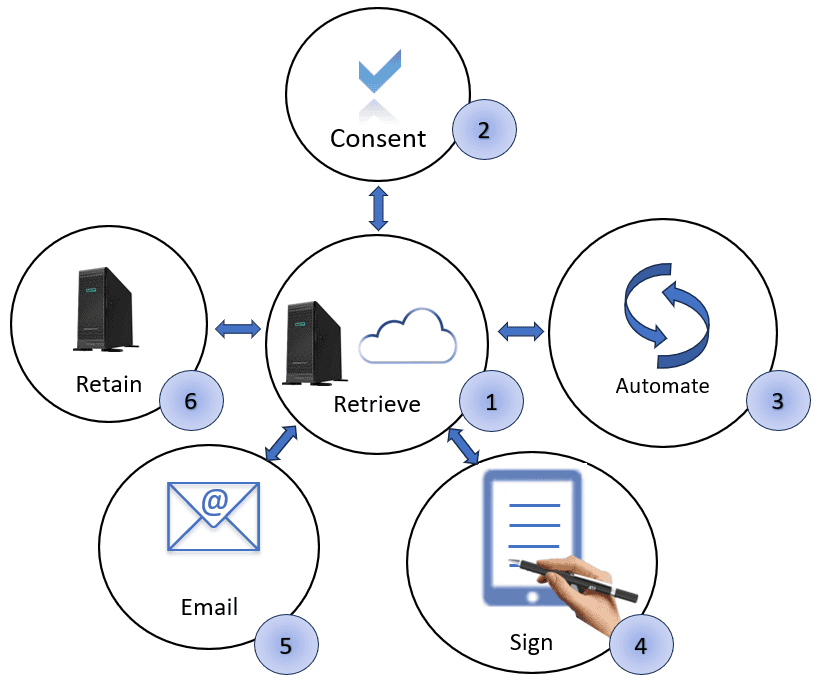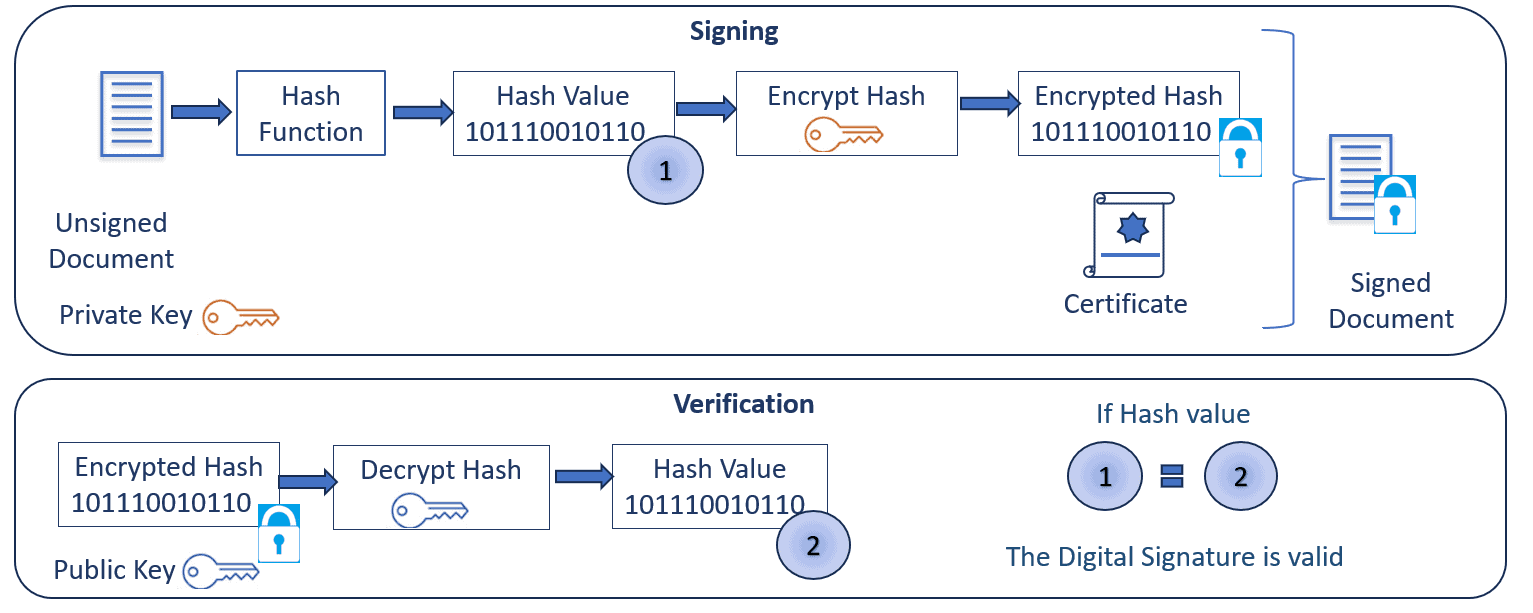1. Introduction
Modern information security relies heavily on electronic and digital signatures. In the digital age, signing papers has changed dramatically. Electronic and digital signatures have replaced the pen-and-paper signature.
In this tutorial, we’ll discuss the workings of electronic and digital signatures, their capabilities and differences, and how they revolutionize document authentication.
2. What Is an Electronic Signature?
An electronic signature, or an e-signature, refers to signing a digital document electronically. It may involve something as easy as entering one’s name into a document, drawing a signature on a mobile device, or tapping an “I accept” button on a web page.
An electronic signature aims to provide a quick and easy way to consent to the information in a digital document.
Although the statutory recognition of electronic signatures varies by jurisdiction, it’s worth learning about them.
3. How Electronic Signatures Work?
The first step is identity verification, which requires a valid email address, a business ID, or a verifiable phone number.
Once the signer’s identity is validated, they sign the document using their preferred electronic method. This procedure is easy, making electronic signatures useful for everyday tasks. Here are its steps:

The first step is to retrieve the documents that need a signature from a document management server (DMS), mail server, or the cloud.
Next, the business workflow sends signers a consent request and links to documents to sign. The signature type can be an e-signature, digital, or physical signature.
Then, the business workflow notifies the document owner and signer and starts recording their actions for future audit trails.
In a regular action flow, the signer puts in their e-signature and returns the contract to DMS to receive an email about successfully signing the document(s).
Ultimately, the business workflow saves the signed contract, signature time stamp, and audit trail.
3.1. Example
Let’s see what happens when we receive an email request to sign a document electronically. Generally, the request to sign includes a link to the document and is accessible via mobile or desktop.
First, we’ll verify our identity using our email, login credentials, security questions, a third-party identity verification service, or a one-time password (OTP).
Afterward, the automated business process will capture signature data, the document, and the audit trail. Then, it will validate the signer’s identity, and the signer will electronically sign the document.
Finally, the automated business process will transmit the signed documents electronically.
4. What Is a Digital Signature?
Digital signatures are a type of electronic signature that offers extra protection. They use the public key infrastructure (PKI) to verify the signer’s identity and the signed document’s integrity.
A digital signature uses cryptography to bind the individual who signed to the record, rendering it tamper-proof.
Further, a digital signature offers an additional degree of confidence concerning the source and condition of an electronic document.
4.1. Cryptography
Digital signatures use asymmetric encryption with a pair of public and private keys and hashing techniques to provide a unique digital fingerprint for the document:

The cryptographic principles behind digital signatures ensure that a document remains unchanged during transit, preventing the sender from eventually contesting it later.
The first step in using PKI is to get a digital certificate. To do so, the sender sends a request for registration to a registration provider.
After validating the sender’s identity, the registration provider forwards the digital certificate request to a certificate server. A certificate server is a trustworthy entity that issues digital certificates.
Furthermore, the certificate server generates a private key and a digital certificate containing the sender’s details. Encrypting the hash with the sender’s private key results in a digital signature. The receiver validates the signature using a third-party verification provider and the public key.
4.2. Digital Certificates
Digital certificates are essential in digital signatures to confirm the certificate owner’s identity as a human, a server, or an organization.
So, a digital signature includes a digital certificate and a public key. This pairing assures that a signature is unique to the signer and has not been altered, preserving the integrity of the signed document.
As a result, a digital certificate generates legally binding digital signatures for authentication and non-repudiation. Moreover, it also serves as a digital passport for secure transactions.
Digital certificates also secure web communications via SSL/TLS protocols. A website’s digital certificate ensures that users’ connections are secured and that they are communicating with a legitimate website.
4.3. How Do Digital Signatures Work?
A digital signature generates a public and private key using a hash algorithm. The two steps involved are signing and verification:

When we sign the document, a cryptographic hash algorithm generates a unique hash value. This hash value is subsequently encrypted using the private key to create the digital signature.
The private key is confidential, but the public key is for others. The recipient of the digitally signed can verify the digital signature with the public key. The recipient compares the hash values of the received document and the digital signature. If they are equal, the digital signature is legitimate and was not tampered with or altered.
4.4. Pros and Cons of Digital Certificate
Let’s now discuss the pros and cons of digital certificates:
**Pros
**
Cons
Protect sensitive data and keep it out of the hands of those who should not have access to it.
Threat actors can compromise the repository of digital certificates the certificate server hosts.
The certificate generation process is highly automated, which makes it very easy to use.
It takes time to validate, encrypt, and decrypt digital certificates.
Cost-effective and cheaper solution.
Integration with diverse systems is challenging.
We can set a process for our digital certificate generation instead of relying on a certificate authority.
As the number of certificates grows, managing renewal and expiry becomes tedious.
Digital certificates provide a strong foundation for online security. Using digital certificate systems can increase security and privacy. They are suitable for transactions in which credibility and reliability are crucial.
4.5. What Are the Best Practices for Maintaining Integrity and Non-repudiation?
Maintaining integrity and non-repudiation in document sharing is critical for assuring transaction authenticity and verifiability.
Best practices in this area include establishing a solid PKI framework to issue digital certificates that confirm the authenticity of each party involved in electronic transactions.
Furthermore, digital signatures should attach an identity to documents and verify that there have been no changes since signing. Timestamp services are essential to comply with legal regulations.
Moreover, we should use multi-factor authentication (MFA) to ensure that the entity conducting a transaction or communicating is who it claims to be. Comprehensive audit trails, including user actions and system activity, are critical for resolving potential disputes.
Education and training are equally important in cultivating a culture of security awareness and compliance among our workforce.
5. Electronic vs. Digital Signature
Let’s discuss the differences between electronic and digital signatures:
**Feature
**
Electronic Signature
Digital Signature
Definition
Electronic process to accept an agreement or a record.
A type of e-signature which employs encryption methods to give evidence of genuine, unmodified information.
Verification
Extra proof is required to verify its legitimacy.
A signed document is confirmed with a certificate-based digital identification.
Legal Compliance
Recognized by law in several countries, but the extent of legal acceptability can vary.
It usually has the same legal significance as a handwritten signature and is accepted in court in multiple countries.
Security
Low degree of security, vulnerable to manipulation and theft.
A substantial degree of protection; encryption prevents manipulation and forgery.
Technology
A cryptographic method isn’t necessary.
Uses PKI to create and validate identities.
Application Area
Suitable for low-risk and safe actions, such as signing nonlegal casual paperwork.
Ideal for high-stakes operations like contractual agreements and financial reports.
When deciding between electronic and digital signatures, we must evaluate the desired level of security and validity.
An electronic signature may be sufficient for daily transactions that do not contain sensitive information. However, a digital signature is better for legal contracts or confidential agreements.
6. Conclusion
In this article, we discussed the types of electronic signatures and their differences and applications.
Choosing between an electronic signature and a digital signature depends on the transaction’s needs, the desired level of security, and the legal framework in place. Even though electronic signatures are convenient and quick, digital signatures are more secure and are better suited for transactions where the validity and integrity of the document are crucial.